Angled loofah
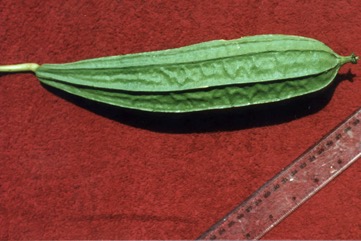
A tropical plant. It grows from sea level to 500 m altitude in the hot humid tropics. It won't tolerate excessive rainfall so does best in drier areas or in the dry season in wetter areas. Day temperatures above 25 °C are suitable. Some varieties require short day length. Adding additional nitrogen fertiliser can stimulate female flower formation in short day varieties. In Nepal it grows between 1000-1600 m altitude. It can grow in arid places. In Yunnan.
Also known as:
Ban-ghirola, Birakaya, Blustru, Boap liam, Bonion, Buap sagi, Buyo-buyo, Daravetakolu, Dishcloth gourd, Emes, Esponga, Estropajo, Gambas, Ghisoda, Hirekayi, Hoyong, Jhika, Jhinga tori, Jhinga, Jhingana, Jhingli, Jhongaka, Jinga, Kabatiti, Kachur, Kala-kha-we, Kali tori, Kali, Kattu pirkuu, Ketola segi, Ketola, Kha-we-yaing, Kimput, Koshataki, Kul-hu-bi, Loofah, Looy, Manoi-liam, Metolak, Muop khai, Murop kai, Oyong, Papangay, Pate ghiraunla, Patola, Patolang, Peeram, Pekunkai, Petola sanding, Petola-sagi, Pichenga, Pirkankai, Pronthai, Ridged gourd, Ronoong chrung, Sataputi, Shiri dodka, Shirola, Si gua, Silk gourd, Sze gwa, Taroi, Tha-but-nwe, Timput, Tokado-hechima, Torai, Vatakolu
Synonyms
- Cucumis acutangulus L.
- Cucumis lineatus Bosc.
- Cucumis megacarpus G. Don
- Cucumis operculatus Roxb. ex Wight & Arn.
- Cucurbita acutangula (L.) Blume
- Cucurbita umbellata Klein ex Willd.
- Luffa acutangula (L.) Roxb. var. amara (Roxb.) C. B. Clarke
- Luffa amara Roxb.
- Luffa drastica Mart.
- Luffa fluminensis Roem.
- Luffa foetida Cav.
- Luffa forskalii Schweinf. ex Harms
- Luffa gosa Ham.
- Luffa umbellata (Klein ex Willd.) M. Roem.
- Momordica tubiflora Wall.
Edible Portion
- Leaves, Fruits, Vegetable, Seeds, Seeds - oil, Flowers
Where does Angled loofah grow?
Found in: Africa, Asia, Australia, Bangladesh, Benin, Burkina Faso, Cambodia, Central America, China, Côte d'Ivoire, Cuba, East Africa, East Timor, El Salvador, Fiji, Ghana, Guam, Guyana, Haiti, Hawaii, Himalayas, India, Indochina, Indonesia, Ivory Coast, Japan, Kenya, Laos, Madagascar, Malaysia, Mauritius, Mozambique, Myanmar, Nauru, Nepal, Nigeria, Northeastern India, Oman, Pacific, Pakistan, Papua New Guinea, PNG, Philippines, Puerto Rico, Russia, SE Asia, Senegal, Sierra Leone, Sikkim, Singapore, Solomon Islands, Southern Africa, South America, Sri Lanka, Tanzania, Thailand, Timor-Leste, Togo, Tuvalu, Uganda, United States, Vanuatu, Vietnam, West Africa, Yemen
Notes: There are 6 Luffa species. The seeds are 26% oil. It possibly has anti-cancer properties.
Status: It is a commercially cultivated vegetable. In Papua New Guinea it is a vegetable of minor importance in some coastal areas.
Growing Angled loofah
Cultivation: Seeds are sown direct at 40 x 80 cm spacing and need stakes to climb. Because seeds can have a hard coating soaking seed in water for 24 hours before planting can assist. 5 kg of seed per hectare are required. The plant benefits from full sunlight. Good soil fertility is beneficial. The soil needs to be well drained and adequate organic matter helps. Pinching out the growing tips when plants are 1.5 to 2 metres long can promote fruit development. Hand pollination once female flowers develop helps fruit set. This is best done in the evening.
Edible Uses: The immature fruit are cooked and eaten as a vegetable. The ridges are removed with a vegetable peeler. The fruit are boiled, steamed or stir-fried. They can be added to soups, stews and curries. The fruit skin is made into chutney. The leaves are edible. They can be eaten in salads or cooked as a vegetable. The flower buds are dipped in batter and sauteed. Mature seeds are roasted, salted and eaten as a snack.
Production: Immature fruit are ready 6-10 weeks after planting. On maturity the fruit become bitter and inedible. Fruit do not store well so are harvested when they are to be used.
Nutrition Info
per 100g edible portion| Edible Part | Energy (kcal) | Protein (g) | Iron (mg) | Vitamin A (ug) | Vitamin c (mg) | Zinc (mg) | % Water |
|---|---|---|---|---|---|---|---|
| Fruit | 17 | 0.7 | 0.5 | - | - | - | 94.6 |
| Leaves | - | 5.1 | 11.5 | - | 98 | - | 89 |
Angled loofah Photos

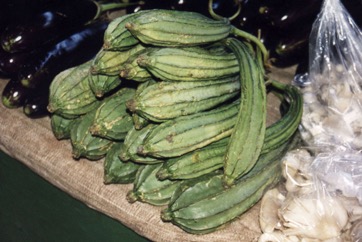
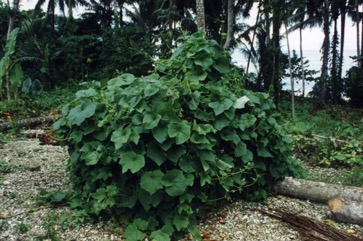
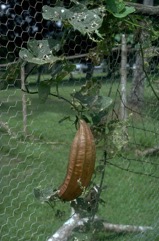
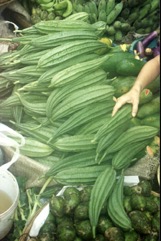
References
Achigan-Dako, E, et al (Eds), 2009, Catalogue of Traditional Vegetables in Benin. International Foundation for Science.
Ambasta, S.P. (Ed.), 2000, The Useful Plants of India. CSIR India. p 339
Anderson, E. F., 1993, Plants and people of the Golden Triangle. Dioscorides Press. p 214
Ara, R. I. T., 2015, Leafy Vegetables in Bangladesh. Photon eBooks. p 151
Arinathan, V., et al, 2007, Wild edibles used by Palliyars of the western Ghats, Tamil Nadu. Indian Journal of Traditional Knowledge. 6(1) pp 163-168
Barrau, J., 1976, Subsistence Agriculture in Melanesia. Bernice P. Bishop Museu, Bulletin 219 Honolulu Hawaii. Kraus reprint. p 55
Burkill, H. M., 1985, The useful plants of west tropical Africa, Vol. 1. Kew.
Burkill, I.H., 1966, A Dictionary of the Economic Products of the Malay Peninsula. Ministry of Agriculture and Cooperatives, Kuala Lumpur, Malaysia. Vol 2 (I-Z) p 1392
Chin, H. F., 1999, Malaysian Vegetables in Colour. Tropical Press. p 41
Ching, L. S. & Mohamed, S., 2001, Alpha-Tocopherol Content in 62 Edible Tropical Plants. J. Agric. Food Chem. 2001, 49, 3101−3105
Creasy, R., 2000, The Edible Asian Garden. Periplus p 46
Dalziel, J. M., 1937, The Useful plants of west tropical Africa. Crown Agents for the Colonies London.
Dansi, A., et al, 2008, Traditional leafy vegetables and their use in the Benin Republic. Genet Resour Crop Evol (2008) 55:1239–1256
Esquinas-Alcazar, et al, 1983, Genetic Resources of Cucurbitaceae. International Board of Plant Genetic Resources.
Facciola, S., 1998, Cornucopia 2: a Source Book of Edible Plants. Kampong Publications, p 87
Fl. ind. ed. 1832, 3:713. 1832
Flora of Pakistan. www.eFloras.org
Foo, J.T.S.(ed), 1996, A Guide to Common Vegetables. Singapore Science Foundation. p 60
Food Composition Tables for use in East Asia FAO http://www.fao.org/infoods/directory No. 534
French, B.R., 1986, Food Plants of Papua New Guinea, A Compendium. Asia Pacific Science Foundation p 111
French, B.R., 2010, Food Plants of Solomon Islands. A Compendium. Food Plants International Inc. p 139
Grubben, G. J. H. and Denton, O. A. (eds), 2004, Plant Resources of Tropical Africa 2. Vegetables. PROTA, Wageningen, Netherlands. p 370
Hedrick, U.P., 1919, (Ed.), Sturtevant's edible plants of the world. p 388
Hu, Shiu-ying, 2005, Food Plants of China. The Chinese University Press. p 706
Japanese International Research Centre for Agricultural Science www.jircas.affrc.go.jp/project/value_addition/Vegetables
Jardin, C., 1970, List of Foods Used In Africa, FAO Nutrition Information Document Series No 2.p 87
Kays, S. J., and Dias, J. C. S., 1995, Common Names of Commercially Cultivated Vegetables of the World in 15 languages. Economic Botany, Vol. 49, No. 2, pp. 115-152
Kiple, K.F. & Ornelas, K.C., (eds), 2000, The Cambridge World History of Food. CUP p 1719
Kumar, A., et al, 2012, Ethnobotanical Edible Plant Biodiversity of Lepcha Tribes. Indian Forester, 138 (9):798-803
Larkcom, J., 1991, Oriental Vegetables, John Murray, London, p 81
Lembogi Biologi Nasional, 1980m Sayur-sayuran. Balai Pustaka, Jakarta. p 24
Liu, Yi-tao, & Long, Chun-Lin, 2002, Studies on Edible Flowers Consumed by Ethnic Groups in Yunnan. Acta Botanica Yunnanica. 24(1):41-56
Macmillan, H.F. (Revised Barlow, H.S., et al) 1991, Tropical Planting and Gardening. Sixth edition. Malayan Nature Society. Kuala Lumpur. p 335
Manandhar, N.P., 2002, Plants and People of Nepal. Timber Press. Portland, Oregon. p 299
Martin, F.W. & Ruberte, R.M., 1979, Edible Leaves of the Tropics. Antillian College Press, Mayaguez, Puerto Rico. p 190
Martin, M.A., 1971, Introduction L'Ethnobotanique du Cambodge. Centre National de la Recherche Scientifique. Paris.
Medhi, P. & Borthakur, S. K., 2012, Phytoresources from North Cachur Hills of Assam -3: Edible plants sold at Hflong market. Indian Journal or Natural Products and Resources. 3(1) pp 84-109
Miguel, E., et al, 1989, A checklist of the cultivated plants of Cuba. Kulturpflanze 37. 1989, 211-357
Miller, A. G., Morris, M. & Stuart-Smith, S., 1988, Plants of Dhofar. The Southern Region of Oman, Traditional, Economic and Medicinal Uses. Sultanate of Oman. p 118
Murtem, G. & Chaudhrey, P., 2016, An ethnobotanical note on wild edible plants of Upper Eastern Himalaya, India. Brazilian Journal of Biological Sciences, 2016, v. 3, no. 5, p. 63-81
Murakami, A. et al, 2014, Screening for the In Vitro Anti-tumor-promoting Activities of Edible Plants from Malaysia. Bioscience, Biotechnology, and Biochemistry, 64:1, 9-16.
Norrington, L., & Campbell, C., 2001, Tropical Food Gardens. Bloomings Books. p 47
Ochse, J.J. et al, 1931, Vegetables of the Dutch East Indies. Asher reprint. p 201
Omawale, 1973, Guyana's edible plants. Guyana University, Georgetown p 95
Ong, H., et al, 2012, Traditional knowledge and usage of edible plants among the Semai community of Kampung Batu 16, Tapah, Perak, Malaysia. Scientific Research and Essays Vol. 7(4), pp. 441-445, 30 January, 2012
Owen, S., 1993, Indonesian Food and Cookery, INDIRA reprints. p 76
Peekel, P.G., 1984, (Translation E.E.Henty), Flora of the Bismarck Archipelago for Naturalists, Division of Botany, Lae, PNG. p 545, 544
Peters, C. R., O'Brien, E. M., and Drummond, R.B., 1992, Edible Wild plants of Sub-saharan Africa. Kew. p 102
Pham-Hoang Ho, 1999, An Illustrated Flora of Vietnam. Nha Xuat Ban Tre. p 568
Phon, P., 2000, Plants used in Cambodia. © Pauline Dy Phon, Phnom Penh, Cambodia. p 409
Plants of Haiti Smithsonian Institute http://botany.si.edu/antilles/West Indies
Prachi, K., et al, 2012, Underutilized wild fruits of North Maharashtra. Journal of Research in Plant Sciences. (2012) 1:071-076
Purseglove, J.W., 1968, Tropical Crops Dicotyledons, Longmans. p 128
Rajapaksha, U., 1998, Traditional Food Plants in Sri Lanka. HARTI, Sri Lanka. p 154
Rashid, H. E., 1977, Geography of Bangladesh. Westview. p 263
Royal Botanic Gardens, Kew (1999). Survey of Economic Plants for Arid and Semi-Arid Lands (SEPASAL) database. Published on the Internet; http://www.rbgkew.org.uk/ceb/sepasal/internet [Accessed 16th April 2011]
Savita, et al, 2006, Studies on wild edible plants of ethnic people in east Sikkim. Asian J. of Bio Sci. (2006) Vol. 1 No. 2 : 117-125 (As Luffa amara)
Schneider, E., 2001, Vegetables from Amaranth to Zucchini: The essential reference. HarperCollins. p 368
Sharma, B.B., 2005, Growing fruits and vegetables. Publications Division. Ministry of Information and broadcasting. India. p 180
Siemonsma, J. S. and Piluek, K. (Eds), 1994, Plant Resources of South-East Asia No. 8 Vegetables. Prosea Foundation, Bogor, Indonesia, p 194
Smith, P.M., 1979, Angled loofah, in Simmonds, N.W., (ed), Crop Plant Evolution. Longmans. London. p 306
Soladoye, M.O. & Adebisi, A.A., 2004. Luffa acutangula (L.) Roxb. [Internet] Record from Protabase. Grubben, G.J.H. & Denton, O.A. (Editors). PROTA (Plant Resources of Tropical Africa), Wageningen, Netherlands. < http://database.prota.org/search.htm>. Accessed 19 October 2009.
Solomon, C., 2001, Encyclopedia of Asian Food. New Holland. p 176
Staples, G.W. and Herbst, D.R., 2005, A tropical Garden Flora. Bishop Museum Press, Honolulu, Hawaii. p 268
Sukenti, K., et al, 2016, Ethnobotanical study on local cuisine of the Sasak tribe in Lombok Island, Indonesia. Journal of Ethnic Foods. 3 (2016) 189-200 p 198
Terra, G.J.A., 1973, Tropical Vegetables. Communication 54e Royal Tropical Institute, Amsterdam, p 57
Thaman, R. R, 2016, The flora of Tuvalu. Atoll Research Bulletin No. 611. Smithsonian Institute p 82
Thomson, G. & Morgan, W., (Ed.) 2002, Access to Asian Foods Newsletter, Vic Govt., Australia Issue 48
Tindall, H.D., 1983, Vegetables in the tropics. Macmillan p. 173
USDA, ARS, National Genetic Resources Program. Germplasm Resources Information Network - (GRIN). [Online Database] National Germplasm Resources Laboratory, Beltsville, Maryland. Available: www.ars-grin.gov/cgi-bin/npgs/html/econ.pl (10 April 2000)
Walter, A. & Lebot, V., 2007, Gardens of Oceania. ACIAR Monograph No. 122. CD-ROM minor species p 18
Walters, T. W., 1989, Historical Overview on Domesticated Plants in China with Special Emphasis on the Cucurbitaceae. Economic Botany 43(3): 297-313
van Wyk, B., 2005, Food Plants of the World. An illustrated guide. Timber press. p 232
Woodward, P., 2000, Asian Herbs and Vegetables. Hyland House. p 89
World Checklist of Useful Plant Species 2020. Royal Botanic Gardens, Kew